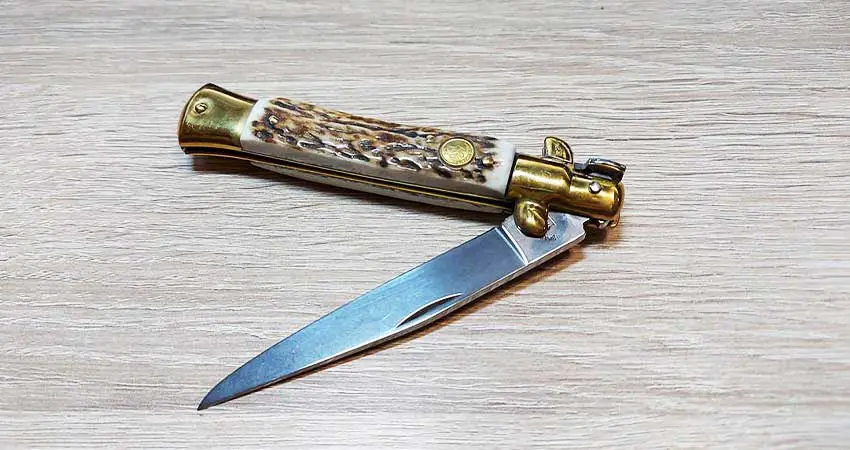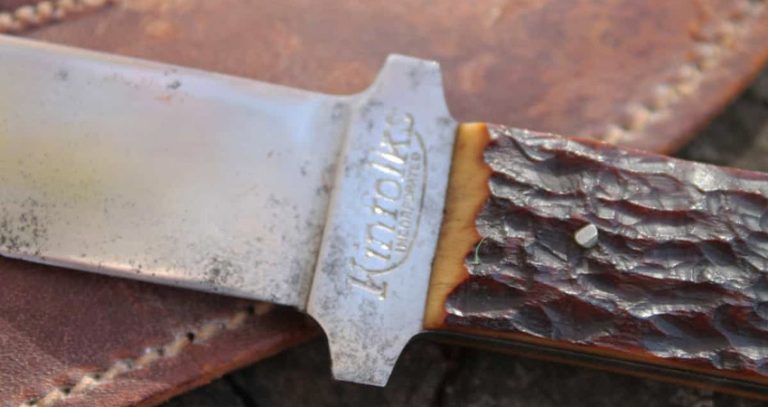How To Date A Kissing Crane Knife?
Kissing crane has a delightful history and a reassuring quality statement. The brand is particularly famous for manufacturing outstanding normal and pocket knives for over a century.
The historical Kissing Crane knives are a force to reckon with, particularly because of their unwavering premium quality.
Although some upcoming companies have been trying to mimic this renowned brand, none of the modern versions can match the original knives.
Most kissing crane knives dating back to the 19th century were produced under the Klaas Company. This was before he (Klaas) changed their trademark to Kissing Crane.
If you’re particular about knife quality, you may want to confirm when your Kissing Crane knives were manufactured.
While at it you should also establish their originality. This is how you can date a Kissing Crane knife effectively.
How To Date A Kissing Crane Knife?

Dating a knife can be straightforward or challenging, depending on the details it bears.
Again, the company has been around for 187 years and has been changing location and ownership, thus affecting its records.
But, with dedication, you can consult and use the available resources to date your Kissing Crane knife.
Below are different methods you could consider in your knife dating endeavor –
Reading The Codes, Pattern Stamps, And Logo

The authentic Kissing Crane antique knives came with some encryptions that are not too hard to decipher even today.
For the numbers, the company had an explicit code for the knife design, the number of blades, and another number to symbolize the handle material.
If you see a number like 3228 then what you’re holding right there is a pre-1990 Kissing Crane knife.
In such a case, 32 represents the pattern, 2 symbolizes the blades, while 8 stands for genuine mother of pearl (the material the handle is made of).
You realize the first two sets of numbers are easy to identify, but decoding the last one can be challenging.
Some of them include;
- 1 symbolizes solid hardwood
- 5 symbolizes genuine stag
- 6.5 stands for BoneStag
On the logo, you won’t find one on knives produced by Kissing Crane after its acquisition by the United Cutlery Company.
The acquisition details are in the kissing crane knife history.
It’s thought that the missing logo is probably because they would not want to have a logo that’s not their original idea.
Kissing Crane has a logo of two identical birds facing the same direction but posing as though they’re kissing.
If what you have is different, your knife may only be about 25 years old.
Looking Out For Roman Numerals

If your knife has a Roman numeral dating system, certainly that’s an older Kissing Crane knife.
Even without further details, you can be sure the knife was produced between 1972 and 1986.
To decrypt the code, you need to know that the Roman number assigned to the year 1972 was XI (read 11).
So, if your knife reads XXII, then it dates back to 1983, and this dating system goes all the way to 1986.
If you’re not used to interacting with Roman numerals, you can do it like this;
- XI implies 1972
- XII implies 1973
- XIII implies 1974
The final year of this batch of knives should read XXV, which corresponds to 1986. You may not get the actual manufacture date, but at least you’ll have substantial information.
If your computation gives you anything above 1986, just know you got it all wrong.
On the same note, you can take the indicated Roman number and add it to 1961 and you will get the actual manufacture year.
For instance, if your knife bears Roman number XVII (number 17), then the year of manufacture is (1961+17), which is 1978. It’s that straightforward.
Checking A Stamp or ‘KC’ Badge

Newer knives manufactured from the early 1990 bear a KC tag or stamps on the blades.
So, this is the hack; if your Kissing Crane knife doesn’t have a KC tag or Roman numerals, then definitely it dates from 1986-1991 or 1994-2004.
When you know your Kissing Crane knife value, you guard it jealously, especially if it dates back to the early days.
Taking It To An Expert
As you think of dating your Kissing Crane knife today, some people have been doing it for years.
They have studied a lot of knife literature and are in a better position to pinpoint distinctive components like the Kissing Crane tang stamps, which are a bit uncommon.
But, select your professionalcarefully to avoid falling for deceitful people.
Also, some may be specialists of other brands, thus lacking meaningful information about Kissing Crane knives.
Things To Consider When Dating A Kissing Crane Knife

Since it’s not easy to find Kissing Crane symbols showing the date or year of manufacture, here are additional things you can consider alongside the above dating methods.
- Knife length
- Materials making the blade and handle
- Blade shape
- Knife resilience
- Number of blades
In the 1980s, other German companies had mushroomed and gained so much popularity in the US.
Although they also supplied penknives and pocket knives, none of these competitors outshined Kissing Crane.
If you can get a knife dating to those years going back, you can be sure of having undiluted quality.
Does Ka-Bar Knife Dating Matter?

Yes, dating a Ka-Bar knife matters a lot. If you’re a knife enthusiast with a particular interest in quality, you’ll want to date your Ka-Bar knife.
The company has been in existence since 1898, boasting over a century of quality production.
It’s interesting that most of their knives have been through World War II. Wouldn’t it be exciting to know when you have such a golden tool in your hands?
After inception, Ka-Bar operated until 1900 before going down, but later in 1902 rose under different ownership.
Again, the new owner-operated it until 1961 when he sold it. The cycle continued and the company changed hands several times until the new era of knives came up.
With over 200 different Ka-Bar knife stamps to help generations identify the knives’ manufacture era, you have every reason to date yours.
It would feel great to have a knife that has changed hands for over a century.
You could also keep such high-quality knives and pass them to your generations.
Conclusion
If you don’t know the age of your Kissing Crane knife, these tips should be helpful. Dating a knife helps you to appreciate its value.
If it has been in use for over a century, consider it an impeccable fit.
A vintage Kissing Crane knife, for instance, is rare to find, yet a wonderful treasure to keep. You may never get such a knife ever again in your lifetime, especially regarding the quality.
Knives made back then were handcrafted with unequaled knowledge and quality materials.
All of this, increases the importance of dating the kissing crane knife even more.









